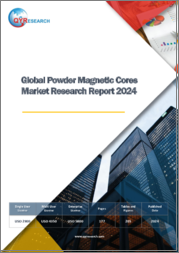
|
시장보고서
상품코드
1621668
메탈 코어 PCB 시장 기회, 성장 촉진요인, 산업 동향 분석과 예측(2024-2032년)Metal Core PCB (MCPCB) Market Opportunity, Growth Drivers, Industry Trend Analysis, and Forecast 2024 to 2032 |
||||||
세계의 메탈 코어 PCB(MCPCB) 시장은 2023년에 137억 달러로 평가되며, 2024-2032년 CAGR 4%로 성장할 것으로 예측됩니다.
이러한 성장의 주요 원인은 에너지 효율적인 조명 솔루션으로의 전환으로 인해 LED 기술에 대한 수요가 크게 증가하고 있기 때문입니다. 금속 코어 PCB는 열 방출을 효율적으로 관리하므로 LED 용도에서 매우 중요하며, LED 조명 시스템이 주거용, 상업용, 자동차 등 다양한 환경에서 형광등과 기존 백열등을 대체하면서 열 관리 기능이 강화된 MCPCB에 대한 수요가 증가하고 있습니다. 스마트 조명과 자동차 조명, 특히 전기자동차의 지속적인 확대는 이 시장의 성장을 더욱 촉진하고 있으며, MCPCB가 에너지 효율적인 최신 조명 솔루션에 필수적인 부품으로서 MCPCB의 역할을 확고히 하고 있습니다.
자동차 부문에서는 산업의 급속한 기술 발전으로 인해 금속 코어 PCB에 대한 수요도 증가하고 있습니다. 전기자동차(EV), 자율주행 시스템, 첨단운전자보조시스템(ADAS)와 같은 혁신에는 내구성과 내열성이 뛰어난 전자부품이 필요합니다. 메탈 코어 PCB는 뛰어난 방열 특성으로 인해 이 점에서 우수합니다. 배터리 관리 시스템, 전력 변환 시스템 등 자동차에 탑재되는 고전력 전자제품의 통합은 MCPCB 시장 성장의 큰 원동력이 되고 있습니다.
이 시장은 층 유형에 따라 단층, 이중층, 다층 MCPCB로 분류할 수 있습니다. 단층 MCPCB 부문은 예측 기간 중 CAGR 3% 이상으로 성장할 것으로 예상됩니다. 단층 MCPCB는 알루미늄이나 구리와 같은 금속 코어에 단일 전도성 구리 층을 장착하고 그 사이에 절연 유전체 층을 끼워 넣습니다. 이 기판은 회로의 복잡성을 최소화하면서 방열을 우선시하는 용도에 적합하며, LED 조명, 자동차 조명, 소비자 전자제품과 같은 산업에서 비용 효율적인 선택이 될 수 있습니다.
| 시장 범위 | |
|---|---|
| 개시년 | 2023년 |
| 예측년 | 2024-2032년 |
| 개시 금액 | 137억 달러 |
| 예측 금액 | 200억 달러 |
| CAGR | 4% |
또한 시장은 심재에 따라 알루미늄 코어 PCB, 구리 코어 PCB, 기타 금속 코어 PCB로 세분화할 수 있습니다. 알루미늄 코어 부문은 2032년까지 90억 달러에 달할 것으로 예상됩니다. 알루미늄 코어 PCB는 우수한 열전도율, 경량성, 비용 대비 성능으로 인해 무게 증가 없이 효율적인 방열이 필요한 용도에 적합합니다. 아시아태평양은 2023년 MCPCB 세계 시장을 주도하며 전체 점유율의 30% 이상을 차지할 것으로 예상됩니다. 이 지역의 우위는 전자 및 제조 산업이 강세를 보이고 주요 기업이 효과적인 열 관리를 위해 MCPCB에 의존하고 있기 때문입니다.
미국 시장 역시 5G 인프라 및 재생에너지 프로젝트와 관련된 자동차 및 통신 산업 수요 증가로 인해 강력한 성장세를 보이고 있습니다.
목차
제1장 조사 방법과 조사 범위
제2장 개요
제3장 산업 인사이트
- 에코시스템 분석
- 밸류체인에 영향을 미치는 요인
- 이익률 분석
- 변혁
- 향후 전망
- 제조업체
- 유통업체
- 공급업체 상황
- 이익률 분석
- 주요 뉴스와 구상
- 규제 상황
- 영향요인
- 촉진요인
- LED 조명의 수요 증가
- 자동차 일렉트로닉스에서의 채택 증가
- 가전제품 시장의 확대
- 통신과 5G 인프라의 진보
- 산업의 잠재적 리스크·과제
- 높은 제조 비용
- 신규 기술의 경쟁
- 촉진요인
- 성장 가능성 분석
- Porter의 산업 분석
- PESTEL 분석
제4장 경쟁 구도
- 서론
- 기업 점유율 분석
- 경쟁 포지셔닝 매트릭스
- 전략 전망 매트릭스
제5장 시장 추정·예측 : 유형별, 2021-2032년
- 주요 동향
- 알루미늄 코어 PCB
- 구리 코어 PCB
- 기타 메탈 코어 PCB
제6장 시장 추정·예측 : 층 유형별, 2021-2032년
- 주요 동향
- 단층 MCPCB
- 2층 MCPCB
- 다층 MCPCB
제7장 시장 추정·예측 : 용도별, 2021-2032년
- 주요 동향
- LED 조명
- 전력 변환기
- 전기자동차
- 태양전지판
- 통신 기기
- 자동차용 전자기기
- 가전제품 제품
- 항공우주·방위
- 의료기기
- 기타
제8장 시장 추정·예측 : 지역별, 2021-2032년
- 주요 동향
- 북미
- 미국
- 캐나다
- 유럽
- 영국
- 독일
- 프랑스
- 이탈리아
- 스페인
- 러시아
- 아시아태평양
- 중국
- 인도
- 일본
- 한국
- 호주
- 라틴아메리카
- 브라질
- 멕시코
- 중동 및 아프리카
- 남아프리카공화국
- 사우디아라비아
- 아랍에미리트
제9장 기업 개요
- ABP Electronics Limited
- Advanced Circuits, Inc.
- Aoshikang Technology Co., Ltd.
- AT&S Austria Technologie & Systemtechnik AG
- Best Technology
- Cirexx International
- Epec, LLC.
- ExPlus Co.
- Focus Technology Co., Ltd.
- Fujikura Ltd.
- HuanYu Future Technologies Co., Ltd.
- Infineon
- Insulectro
- Isola Group
- Meyer Burger Technology AG
- Mitsubishi Materials Corporation
- RIGIFLEX TECHNOLOGY INC.
- Sierra Circuits, Inc.
- Technotronix
- Viasion Technology Co., Ltd.
The Global Metal Core PCB (MCPCB) Market was valued at USD 13.7 billion in 2023 and is projected to grow at a CAGR of 4% from 2024 to 2032. This growth is primarily driven by the global shift towards energy-efficient lighting solutions, which has significantly increased the demand for Light Emitting Diode (LED) technology. Metal core PCBs are crucial in LED applications as they efficiently manage heat dissipation. As LED lighting systems continue to replace fluorescent bulbs and traditional incandescent in various settings, including residential, commercial, and automotive, the demand for MCPCBs with enhanced thermal management features is on the rise. The ongoing expansion of smart lighting and automotive lighting, especially in the context of electric vehicles, is further fueling this market growth, solidifying the role of MCPCBs as vital components in modern energy-efficient lighting solutions.
In the automotive sector, the demand for metal core PCBs is also increasing due to the industry's rapid technological advancements. Innovations such as electric vehicles (EVs), autonomous driving systems, and advanced driver-assistance systems (ADAS) require durable and heat-resistant electronic components. Metal core PCBs excel in this regard, thanks to their exceptional heat dissipation properties. The integration of high-power electronics in vehicles, including systems for battery management and power conversion, is a significant driver of growth within the MCPCB market.
The market can be categorized based on layer type into single-layer, double-layer, and multi-layer MCPCBs. The single-layer MCPCB segment is anticipated to grow at a CAGR of over 3% during the forecast period. Single-layer MCPCBs consist of a single conductive copper layer mounted on a metal core, typically aluminum or copper, with an insulating dielectric layer in between. These boards are ideal for applications that prioritize heat dissipation with minimal circuit complexity, making them a cost-effective choice for industries such as LED lighting, automotive lighting, and consumer electronics.
| Market Scope | |
|---|---|
| Start Year | 2023 |
| Forecast Year | 2024-2032 |
| Start Value | $13.7 Billion |
| Forecast Value | $ 20 Billion |
| CAGR | 4% |
Additionally, the market can be segmented by core material into aluminum core PCBs, copper core PCBs, and other metal core PCBs. The aluminum core segment is expected to reach USD 9 billion by 2032. Aluminum core PCBs are favored for their excellent thermal conductivity, lightweight nature, and cost-effectiveness, making them ideal for applications that require efficient heat dissipation without adding significant weight. The Asia-Pacific region led the global MCPCB market in 2023, accounting for over 30% of the total share. This region's dominance is attributed to its robust electronics and manufacturing sectors, with major players relying on MCPCBs for effective heat management.
The U.S. market is also experiencing strong growth, driven by increasing demand from the automotive and telecommunications industries, particularly related to 5G infrastructure and renewable energy projects.
Table of Contents
Chapter 1 Methodology & Scope
- 1.1 Market scope & definitions
- 1.2 Base estimates & calculations
- 1.3 Forecast calculations
- 1.4 Data sources
- 1.4.1 Primary
- 1.4.2 Secondary
- 1.4.2.1 Paid sources
- 1.4.2.2 Public sources
Chapter 2 Executive Summary
- 2.1 Industry synopsis, 2021-2032
Chapter 3 Industry Insights
- 3.1 Industry ecosystem analysis
- 3.1.1 Factor affecting the value chain
- 3.1.2 Profit margin analysis
- 3.1.3 Disruptions
- 3.1.4 Future outlook
- 3.1.5 Manufacturers
- 3.1.6 Distributors
- 3.2 Supplier landscape
- 3.3 Profit margin analysis
- 3.4 Key news & initiatives
- 3.5 Regulatory landscape
- 3.6 Impact forces
- 3.6.1 Growth drivers
- 3.6.1.1 Increasing demand for LED lighting
- 3.6.1.2 Rising adoption in automotive electronics
- 3.6.1.3 Expansion of consumer electronics market
- 3.6.1.4 Advancements in telecommunications and 5G infrastructure
- 3.6.2 Industry pitfalls & challenges
- 3.6.2.1 High manufacturing costs
- 3.6.2.2 Competition of emerging technologies
- 3.6.1 Growth drivers
- 3.7 Growth potential analysis
- 3.8 Porter's analysis
- 3.9 PESTEL analysis
Chapter 4 Competitive Landscape, 2023
- 4.1 Introduction
- 4.2 Company market share analysis
- 4.3 Competitive positioning matrix
- 4.4 Strategic outlook matrix
Chapter 5 Market Estimates & Forecast, By Type, 2021-2032 (USD Million)
- 5.1 Key trends
- 5.2 Aluminum core PCBs
- 5.3 Copper core PCBs
- 5.4 Other metal core PCBs
Chapter 6 Market Estimates & Forecast, By Layer Type, 2021-2032 (USD Million)
- 6.1 Key trends
- 6.2 Single-Layer MCPCBs
- 6.3 Double-Layer MCPCBs
- 6.4 Multi-layer MCPCBs
Chapter 7 Market Estimates & Forecast, By Application, 2021-2032 (USD Million)
- 7.1 Key trends
- 7.2 LED lighting
- 7.3 Power converters
- 7.4 Electric vehicles
- 7.5 Solar panels
- 7.6 Telecommunications equipment
- 7.7 Automotive electronics
- 7.8 Consumer electronics
- 7.9 Aerospace and defense
- 7.10 Medical devices
- 7.11 Others
Chapter 8 Market Estimates & Forecast, By Region, 2021-2032 (USD Million)
- 8.1 Key trends
- 8.2 North America
- 8.2.1 U.S.
- 8.2.2 Canada
- 8.3 Europe
- 8.3.1 UK
- 8.3.2 Germany
- 8.3.3 France
- 8.3.4 Italy
- 8.3.5 Spain
- 8.3.6 Russia
- 8.4 Asia Pacific
- 8.4.1 China
- 8.4.2 India
- 8.4.3 Japan
- 8.4.4 South Korea
- 8.4.5 Australia
- 8.5 Latin America
- 8.5.1 Brazil
- 8.5.2 Mexico
- 8.6 MEA
- 8.6.1 South Africa
- 8.6.2 Saudi Arabia
- 8.6.3 UAE
Chapter 9 Company Profiles
- 9.1 ABP Electronics Limited
- 9.2 Advanced Circuits, Inc.
- 9.3 Aoshikang Technology Co., Ltd.
- 9.4 AT&S Austria Technologie & Systemtechnik AG
- 9.5 Best Technology
- 9.6 Cirexx International
- 9.7 Epec, LLC.
- 9.8 ExPlus Co.
- 9.9 Focus Technology Co., Ltd.
- 9.10 Fujikura Ltd.
- 9.11 HuanYu Future Technologies Co., Ltd.
- 9.12 Infineon
- 9.13 Insulectro
- 9.14 Isola Group
- 9.15 Meyer Burger Technology AG
- 9.16 Mitsubishi Materials Corporation
- 9.17 RIGIFLEX TECHNOLOGY INC.
- 9.18 Sierra Circuits, Inc.
- 9.19 Technotronix
- 9.20 Viasion Technology Co., Ltd.
















